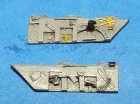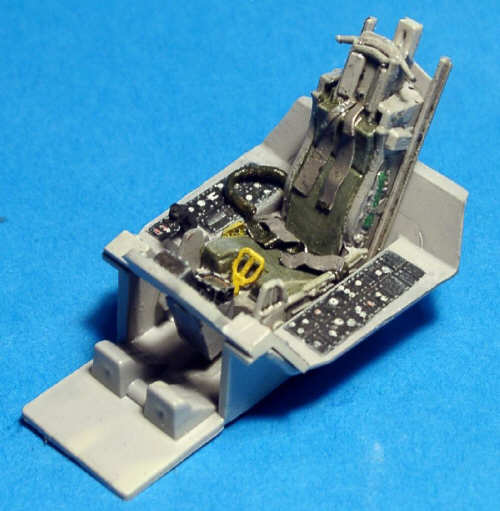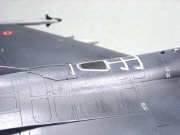|
Legal Notice
No material from Modeler Site any Web site owned, operated, licensed, or controlled by Mario Covalski & Associated may be copied, reproduced, republished, uploaded, posted, transmitted, or distributed in any way, except that you may download one copy of the materials on any single computer for your personal, non-commercial home use only, provided you keep intact all copyright and other proprietary notices. Modification of the materials or use of the materials for any other purpose is a violation of Mario Covalski & Associated's copyright and other proprietary rights.
Read More here > Legal notice
In Italy we are celebrating a new age for our Air Force, marked by the advent of the "old" F-16, called as a stop gap for the belated Eurofighter 2000. A group of 30 "Viper" will be leased from USAF to fill the gap on many Italian bases still for quite a lot years.
I wanted to realize as soon a model of the "new" Italian fighter, beginning when still it had not left Hill AFB in the USA, so I "selected" with care (the usual misfortune!) the unique example (serial 80-0615 originally a F-16A-15B-CF) which has not arrived in Italy, but had a mishap in Newfoundland and came back to the USA.
The model
Having exhausted my escort of Hasegawa, I have tried with an Italeri kit, which "on paper" presented itself fairly well. Practically I discovered that it's a kind of "poor brother" of the Japanese kit, substantially correct in shape, but full of more or less serious faults, and surely not so easy to fit.
The box #841 offers the F-16A in service with the Montana Air National Guard and the Belgian and Dutch Air Force. The paneling is engraved and fairly good, and the ruggedness of the surface is lower than other Italeri productions, while the plastics quality is good.
|
The seat in five pieces is surely among the good things of the kit, in fact is well detailed and doesn't need ameliorations, so I added the belts with adhesive paper. The cockpit is well done with the side consoles, just like the instrument panel which is correct for this version. I detailed the interiors with resin pieces of the Black Box, such as the side walls and the inferior part of the central console. The interior of the cockpit and the seat are in Dark Gull Gray FS 36231 (Gunze H317), with the panels, the upper lip of the instrument panel and the side edges in semi-gloss Black. The stuffing of the seat is in middle Green.
|

|

|
|
The fuselage is split horizontally and the closing has been fairly hard-working, specially on the back sides of the fuselage which require a lot of plaster.
A point on which the kit makes a big mistake is the exhaust, with a wrong number of petals and for which also this time my friend Lucio Martino furnished me a very handsome resin scratch built piece with inside detail of the petals with Verlinden photo-etched pieces.
The tail is of the short type on the Italian Vipers.
|

|
The landing gears are acceptable and need only the usual brake piping. Also the wheels are fairly good. The landing gears, the circles and the recessions are in gloss white.
One of the worst things is the canopy, which beyond to miss the correct section of the Hasegawa kit, has a wrong shape of the back pieces, in fact it's too long and lies suspended inside the back cockpit and necessitates some plasticard for create a correct support for it.
Additionally Italian plane has the brownish plexiglas, present on the Hasegawa kit but not on the Italeri one. I immerged the piece in the Future wax lightly colored of Brown acrylic.
|
Here is the list of the necessary modifications to obtain an Italian ADF: under the fin I scratch built two long bulges, made with an outline of plasticard finished with Milliput; on the nose and under the air intake I inserted some panels of shaped plasticard with the four little blade antennas made with thin plasticard.
The gun nozzle is of the simplified type of the F-16C present in the kit; on the left side of the nose I practiced a small hole for the search light, with the bottom painted with Aluminum and finished with a drop of Kristal Klear; in my example there are two shaped reinforcing plates on the back, to the base of the fin, done with adhesive dielectric ribbon.
|

|
|

|
I recall you that however the bulges at the base of the fin are in the old Revell F-16 ADF kit (don't confuse it with the recent Italeri reboxed by Revell). In the Verlinden Super Detail Set n. 375 are the photo etched blade antennas. In 1/72 scale the correct kit for the ADF is the Fujimi.
Painting
The paint scheme is the classic "three tones" of Grey currently used at Hill AFB: upper surfaces in Dark Grey FS.36118 (Gunze H305) with the exclusion of the fin, ventral fins and lateral back zones, which are instead in Middle Grey FS.36231 (Gunze H317), while the under surfaces and the area ahead of the cockpit is in Grey Blue FS.36375 (Gunze H308) and the radome in Grey FS.36320 (Gunze H307).
In effect the most difficult things are the insignia, not as for the roundels (taken from the Tauro sheet 48-553 for the Tornado operation "Locusta" - Desert Storm), but as for the to low visibility stencils in Grey FS. 36231, for which I sacrificed various part of my spare decals. For those around the nose I used those for the A-10 in Black, lightened with a light coat of Grey Blue. Walkways are missing, and the scripts "no step" and the dorsal scheme for the refueling point was taken from the Hasegawa sheet. The badge of the 37° Stormo (Wing) on the fin has been designed with a PC (with Corel Draw), and printed with a laser printer on a Bare Metal decal sheet.
Finally I gave a very light weathering, in as the airplane has been fresh painted. I used a mix of Brown and Cobalt Blue oil paint to accentuate the paneling of the kit.
The loads represent a hypothesis of standard interception configuration, with two wing tanks, two AIM-9 Sidewinders on the wing tips and two AIM-120 Amraam (taken from the Hasegawa kit) on the external pylons, all with the Grey and Black real armament scheme.
Support us ordering our notes in PDF > Here
|


















